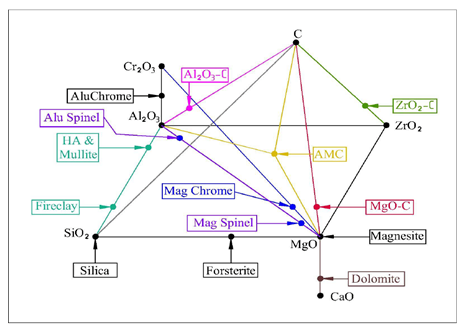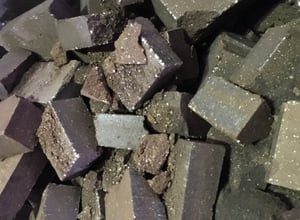
Generally, refractories are classified as basic, high alumina/silica, fireclay and insulating. There are also classes of “special refractories” which include Silicon Carbide, Silicon Nitride, Graphite, Zircon, Zirconia, fused cast and several others. Most refractory materials are supplied as preformed shapes. However, they also are manufactured in the form of special purpose clays, bonding mortars and monolithic such as castable, plastic refractories, ramming mixes and gunning mixes. In fact, many refractories materials have been developed specifically to meet the service conditions of a particular process. The characteristic properties of each refractory class are a function of both their raw material base and the methods used to manufacture the refractory products.
Shaped Refractory manufacturing involves five processes: raw material processing, raw material mixing, forming, drying and firing. Another types of refractory processes also warrant discussion - the first is production of fused products and the second is ceramic fiber production.
For the shaped refractory, forming consists of mixing the raw materials and forming them into the desired shapes. The forming process is a big challenge for shape refractories producer (See Fig.1) because refractory raw materials are almost non plastic materials and they are not bonded with each other at low temperature even if this process frequently occurs under wet or moist conditions. Therefore most refractory producers have to press with very high pressing pressure, control the packing curve of all raw material to obtain the highest density and have to use binder in their forming process to avoid breakage and chipping before achieving the ceramic bond after firing.

Figure 1. Major Refractory Raw Materials & Associated Refractories
There are many kinds of binders for shaped refractory to improve compressive strength for pressing, handling and drying processes to avoid breakage and chipping such as Phenolic Resin, Polyvinyl Alcohol (PVA), Dextrin, Starch, Lignosulfonate, Molasses, Carboxyl Methyl Cellulose (CMC) etc. So, binder selection can be very challenging and producers have to consider many parameters to ensure what kind of binder is suitable for their product and process.

Some of the parameters to consider are as below:
- Type of refractory
- Mixing technology
- Pressing process
- Size and shape of brick
- Drying process
- Handling process
- Firing process
The best binder must have several characteristics:
- It must be easy to add and mix with a refractory aggregate
- It does not react with refractory mixes at low and high temperature
- It must leave a minimal amount of residue after firing
- It must easily burn out at during the firing process
- It does not affect the Bulk Density and Apparent Porosity after pressing, drying and firing
- It must improve the mechanical strength of green and dry bricks
- It must improve flow ability of mixes during pressing to get consistent density in whole bricks
- It does not affect the permanent linear change of bricks
- It does not cause the mixes to stick to the moulds
- It cannot be toxic and cause of air pollution
- It does not affect the refractoriness of the bricks
- It must be as inexpensive as possible
There are no all-in-one binders. The selection of a suitable binder is key to increase a production yield and saving operation cost for refractory producers.
Biopolymer binders offer a unique range of solutions for process and quality improvement. We have developed additives specific to the manufacturing of hydraulic pressed bricks, plastic shaped bricks and other unshaped refractory products. Our natural products have a neutral CO2 footprint, are environmentally friendly and non-hazardous.
Possible benefits during process:
- Improved workability and handling of refractory mixes
- Reduction of pressing friction for dry pressed bricks
- Improved mechanical strength of green and dry bricks
- Increased plasticity for extruded bricks
- Lubrication during forming process
- Energy saving
- Reduced losses during handling and drying process
- Process and quality improvement
Lastly, it is very important to have the opinion of experts in the field and test thoroughly the results obtained in order to select the best binder possible for your specific production process.





